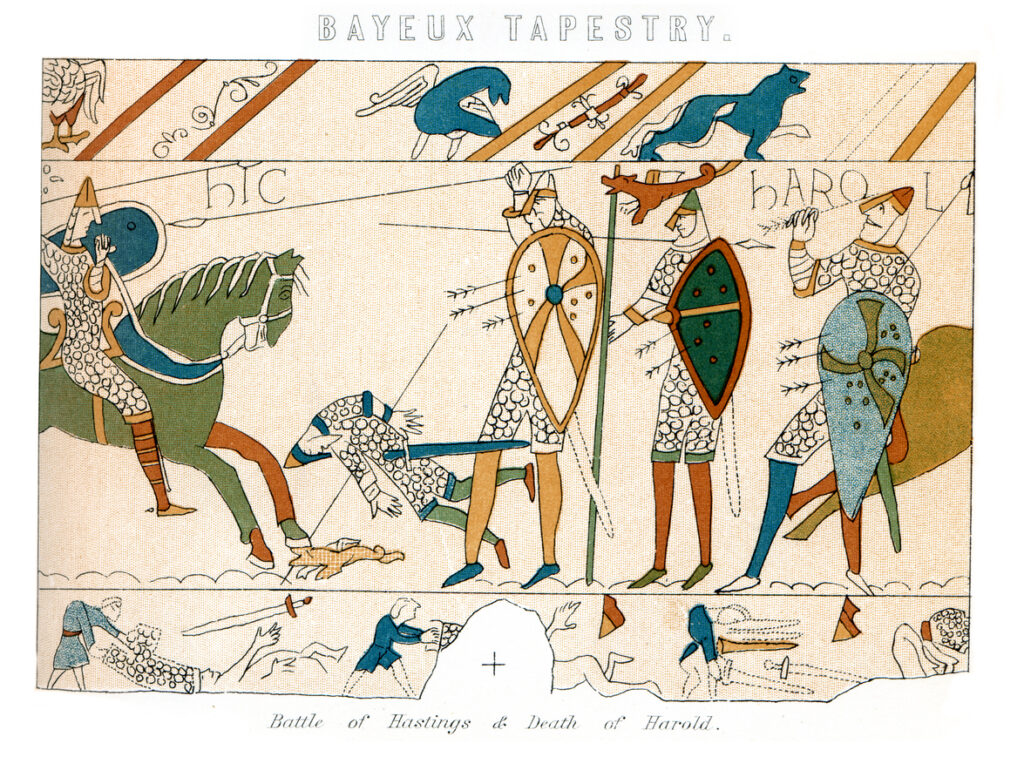For most people, the Battle of Hastings should be familiar. After all, it pretty much rewrote the history books, altering the timeline of England forever.
With that said, even if you have heard of it, you might be sketchy on the details. 1066 was a long time ago, and if you weren’t paying attention in history class, you may have missed some of the key ins and outs.
So, with that in mind, we present a whistlestop guide to the Battle of Hastings, including essential facts about the battle and its aftermath. We’ve tried to answer some of the most obvious questions people have about the battle, so you can get up to speed ahead of your visit to Smugglers Adventure.

Where did the Battle of Hastings take place?
Why, here in Hastings, of course!
Yes, you guessed it, the Battle of Hastings took place in Hastings, a seaside town in East Sussex on the edge of the English Channel. At least, it took place close to Hastings, with the battle actually fought in a field eight miles to the northwest on a site called Senlac Hill.
Of course, back then, Kent wasn’t the well-populated county it is today. Sure, Saxon settlements were dotted throughout and a Roman-age fort was still in place close to Hastings, but there was very little by way of defences to stop the storm that would soon be buffering England’s shores.
Who was involved in the Battle of Hastings?
The Battle of Hastings was fought between the last Anglo-Saxon king, Harold Godwinson, and the Duke of Normandy, better known today as William the Conqueror.
Although there’s no official record of the number of people involved in the battle, experts estimate that the Anglo-Saxons were vastly outnumbered by the Norman invaders. It’s thought there may have been as few as 5,000 Saxons versus up to 12,000 Normans, though it’s impossible to tell how accurate these figures are.

Why did the Battle of Hastings take place?
That’s a good question with a complex answer.
The prelude to the battle began in the 10th century when a group of Vikings established a settlement in the region of Normandy. From this came a marriage between the Viking King Ethelred to Emma of Normandy, who would go on to have a son, Edward the Confessor, the future King of England.
When Edward the Confessor died in January 1066, there was no clear heir to the throne, with several contenders staking their claim. Harold Godwinson, being the closest to the line of successions, proved successful in his claim, ascending to the throne.
Almost immediately, two challengers emerged to question Harold’s claim: Harold Hadrada of Norway and William, Duke of Normandy. Hadrada would strike first, invading England to the north, but was defeated by Godinwson’s forces at the Battle of Stamford Bridge. Then, seizing the opportunity, the Duke of Normandy crossed the English Channel, catching Godwindon by surprise and facing a long march to the south coast.
When did the Battle of Hastings start and how long did it last?
The Battle of Hastings officially began at around 9am on Saturday 14th October 1066. By this point, Duke William had already been in England for over a week, establishing a garrison in the old Roman fort at Hastings; by contrast, Godwinson’s forces were exhausted and depleted after the earlier clash with Harold Hadradra, with a gruelling march south to contend with.
The battle itself lasted until dusk, with Harold Godwinson killed in the process. Despite being heavily outnumbered and without cavalry, the Saxons proved staunch resistance to the Norman invaders, though when Godwinson fell, they were quickly overcome and defeat was swift.
By 15th October, the Battle of Hastings was over, with Godwinson proclaimed dead. William’s ascension to the English throne wasn’t automatic, however, with the duke forced to march on London to take the crown from the remaining Saxon lords by force.

Is the Battle of Hastings related to Hastings Castle?
Yes, it certainly is!
According to the history of Hastings Castle, it was built in 1067, a year after the infamous battle. By this time, William the Conqueror was the undisputed King of England, and the Normans had established a brutal rule across most parts of the country – a period referred to as the Norman Conquest.
In order to shore up his rule and establish dominance over would-be challengers to the throne, William ordered the construction of a string of castles up and down the country. One of these was Hastings, with the stone version you see today built on the site of an earlier wooden motte and bailey keep which was constructed hastily by the Normans when William first arrived on England’s shores.

What remains of the Battle of Hastings today?
The site of the Battle of Hastings is arguably one of the most invaluable heritage sites in England, so it’s a small wonder that thousands of people visit Senlac Hill, Battle Abbey and Hastings each year. The question is: is there much to see when you get here?
Yes, actually. As well as a deep sense that you’re standing on an important spot, there’s plenty to see and do around Hastings that relates directly to the 11th-century battle. You can, for example, visit Battle Abbey to learn more about the legacy and aftermath of the battle, as well as visit the Harold Stone – a stone slab reputed to lay where the last Saxon king fell in battle. Incredible, goosebump-raising stuff.
So there you have it, a highly abridged look at the Battle of Hastings and its cultural impact. Of course, history books can only tell you so much, so for a truly immersive look back at this momentous event, Find out more about visiting Hastings Castle & Smugglers Adventure.
